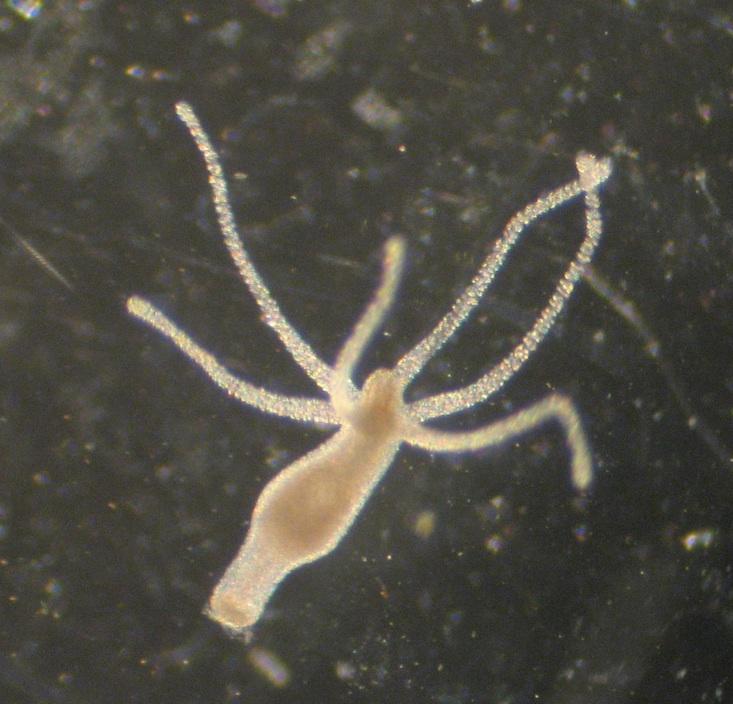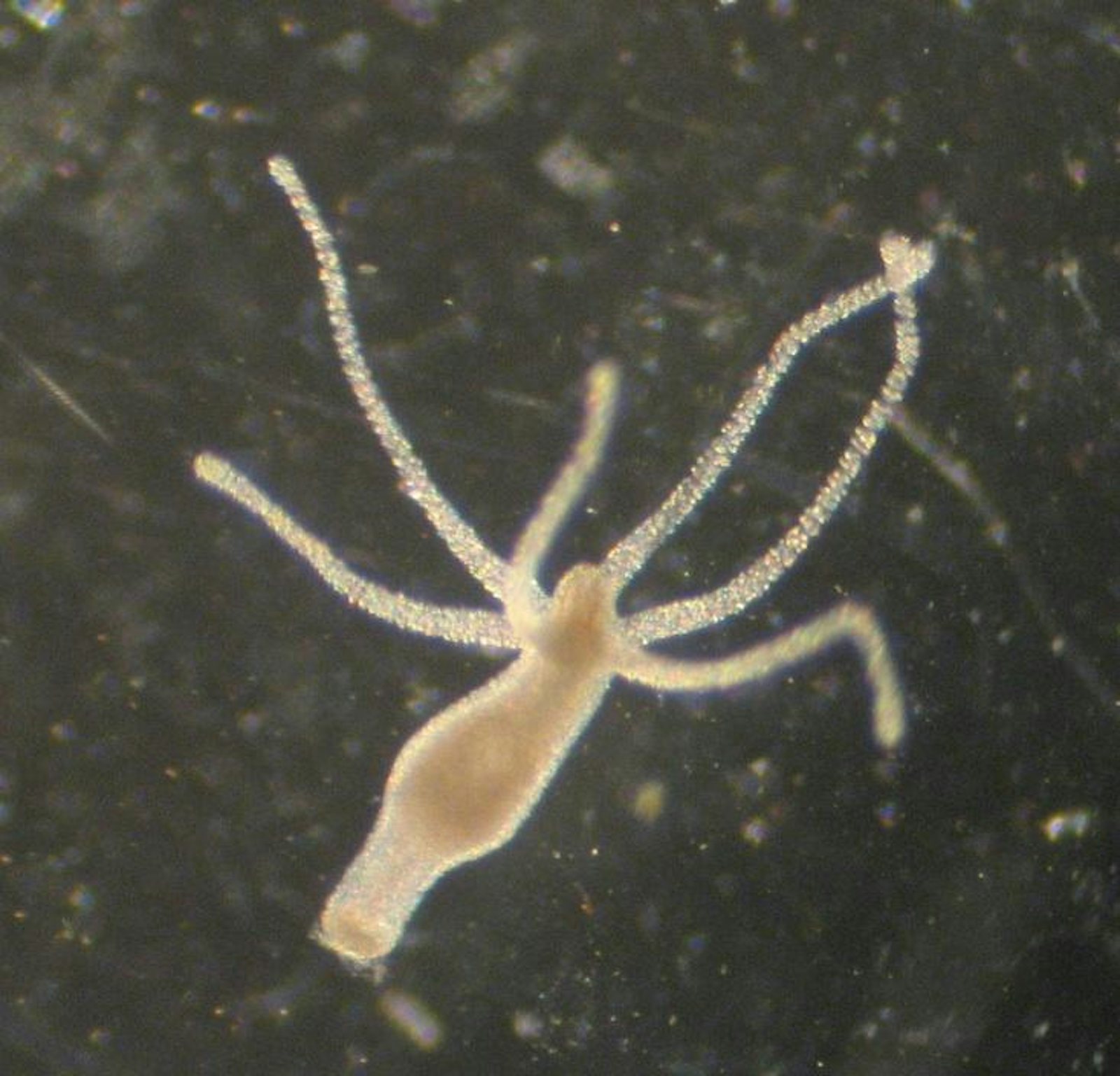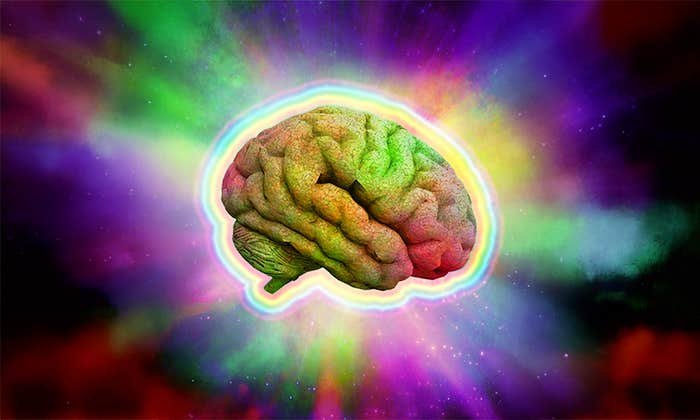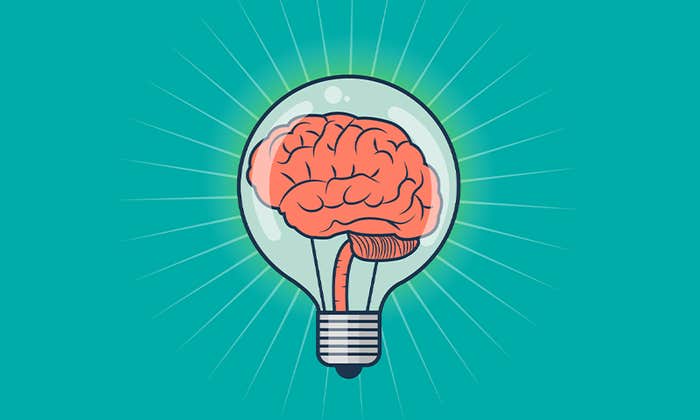
Rafael Yuste thinks neuroscientists have been looking at the brain too close. “It’s just like a TV screen—if you’re watching a movie and could only look at an individual pixel, you would never understand what’s going on,” he says. “What neuroscientists have been doing since [the father of neuroscience, Santiago Ramon y] Cajal, is looking at the single pixels of the brain—one neuron at a time. So that’s why we need these methods to see the whole screen, to see what’s playing in our brains.” The methods in question were on display in a recent study he and his graduate student, Christopher Dupre, conducted, recording the activity of all neurons in the Hydra vulgaris, a centimeter-long hydroid, while the animal swam between two pieces of glass. Take a look.
They correlated that activity to the animal’s behavior—a major conceptual and experimental breakthrough, and arguably the most complete dataset neuroscientists have, which might allow scientists to better understand how interactions among neurons control behavior.
Much can be learned from the simplest of organisms—even ones without a brain.
Dupre got the work started. In 2011, he arrived at Columbia University, in New York City, envisioning he would use microscopes and lasers to understand how the mammalian cortex works, one of the key questions in neuroscience. Yuste’s lab was the perfect place for this, given Yuste’s expertise in visualizing the activity of vast networks of neurons in mouse brains with some of the most sophisticated tools. Since 2013, the Yuste lab has been one of the drivers of the Obama-backed BRAIN Initiative, a $100 million project that aims to develop the technology necessary to record the activity of all neurons in an organism. For scientists studying mammals, that goal is still lofty, as most of them routinely image just hundreds or thousands of neurons simultaneously in mice, whose brains house millions of neurons. Thus, the appeal of the Hydra, which has much fewer neurons to work with.
The idea to try imaging the Hydra was a sort of practice run for the BRAIN Initiative’s biggest goal. Capturing the entire neuronal activity in an organism—something Yuste and others have termed the BAM, or Brain Activity Map—is also part of a test of an hypothesis: that the building blocks of nervous systems are networks of neurons rather than individual neurons, as Cajal had postulated. Dupre had spent two years working on eight failed mouse cortex projects, trying, without much luck, to capture the dynamics of dendrites. For him, putting Hydra under a microscope was a sort of homecoming, having worked on these creatures in high school. While some have studied individual neurons in Hydra, no one had yet imaged their neuronal activity. “It was completely unexplored, so I thought at least whatever I see there is going to be new,” Dupre told me.
One could write a listicle on the fascinating factoids about Hydra. Most interesting is that these hydroids are essentially immortal: They are capable of regenerating themselves via asexual reproduction, during which a genetically identical twin buds off from a fully grown animal (they are also capable of such regeneration if cut into several pieces). Most useful for imaging, though, is the fact that Hydra are thin and transparent, allowing one to use a simple microscope to see the whole creature, one of the earliest organisms to have a nervous system. Its neurons—typically several hundred of them—form nets spanning its body rather than a brain. As it squirms, you can see, in movies of the creature, chains of neurons, connected by thin wires, called dendrites, which allow neurons to communicate. These chains light up like cities at night seen from orbit as the animal elongates in response to light, contracts when disturbed, nods when exploring, or just somersaults to get around. By analyzing the activity of all neurons simultaneously, Dupre and Yuste found that each animal has four networks of co-active neurons, each of which was excited during a particular behavior.
How does the brain transform the sensory input into a behavioral output?
The Hydra story makes clear that the adventure does not stop after the data collection. As Florian Engert, a neuroscientist at Harvard University, wrote in 2014, the key challenge in such endeavors is turning the data into knowledge. He recently cautioned that the key next step would be to create a computational model of Hydra’s nervous system that would be able to make testable predictions about how any given neuron contributes to the animal’s behavior. “Alone, [the data] is not sufficient to explain anything. You need to back it up with a model. If you have no idea how it works, then whole brain imaging will not give you that,” he told me. “The Hydra forces you to go to the next level, and try to somehow make sense of it and embed it in a larger picture of neuroscience.”
In a paper he published last year, led by postdocs Eva Naumann and James Fitzgerald, Engert’s team did just that. They imaged the activity of nearly all 100,000 neurons in a larval zebrafish simultaneously while presenting various visual stimuli and measuring the fish’s reflexive swimming behavior. (Those experiments did not count as completely imaging the entire nervous system because the fish’s spinal cord and retinas were left out). The experiments started with an observation of a behavior: that when the world looks like it’s drifting to the left, the fish compensates by turning in the same direction, trying to turn to follow the drift (and vice versa for right drifts). Their question: How does the brain transform the sensory input into a behavioral output?
Engert’s whole-brain experiment turned data into knowledge by selecting a specific behavior, which is reliably coupled to a sensory stimulus, and modeling its control by the nervous system. Without this, the brain data would have remained just numbers on a very large hard drive. Asking specific questions, usually related to behavior, is what Engert thinks will be key to figuring out how the brain works—and he’s not alone. John Krakauer, a neuroscientist at Johns Hopkins Hospital, and colleagues, titled a recent paper, “Neuroscience Needs Behavior: Correcting a Reductionist Bias.” Basically, Krakauer said, “People think technology + big data + machine learning = science. And it’s not.”
When I visited Yuste’s lab this summer, he told me that his team is now working, as part of a DARPA-funded project involving multiple labs, on a computational model of Hydra’s nervous system and planning experiments that would manipulate Hydra’s neural nets. Some of the work is aimed at integrating information from the environment, for example, such as changes in gut pressure as the animal eats, to better understand the neuronal activity in the body.
Dupre, for his part, will continue working on the Hydra as a postdoc in Engert’s lab, at Harvard, hopefully showing that much can be learned from the simplest of organisms—even ones without a brain.
Grigori Guitchounts is a graduate student in neuroscience, studying mechanisms of visual object recognition in rodents.
WATCH: Why is consciousness not an emergent property of the brain.



























